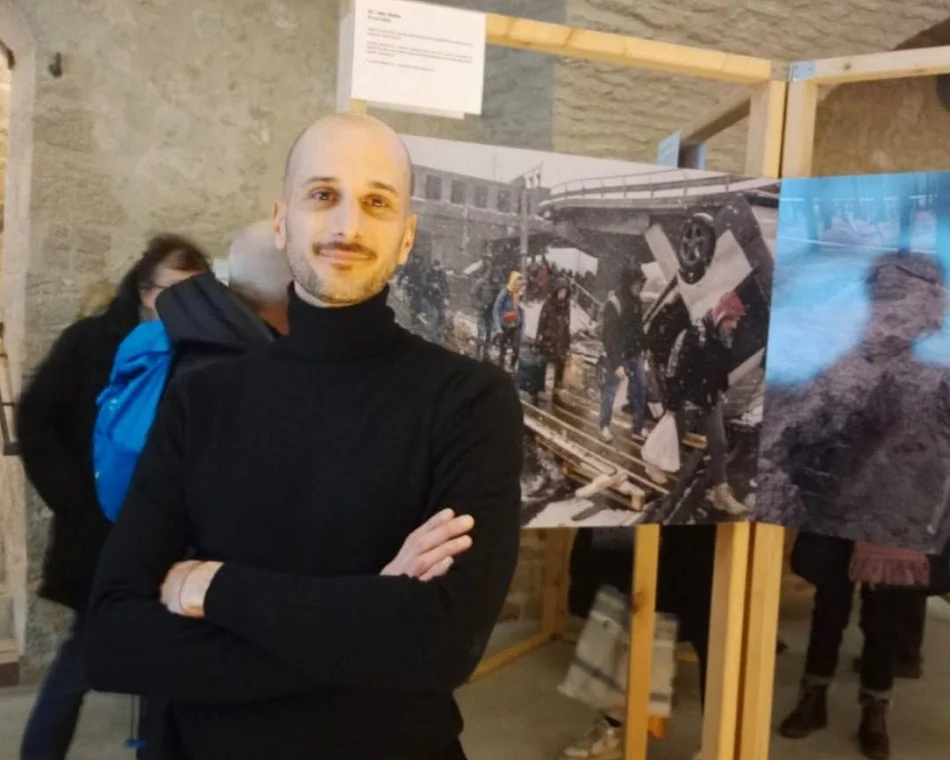By Elena Vasquez, Senior Correspondent for The Guardian
Kyiv, Ukraine – October 3, 2025
In the shadowed trenches of eastern Ukraine, where the line between survival and oblivion blurs under the relentless hum of drones, the war claimed yet another life today—one that echoes far beyond the shattered streets of Donetsk. Antony Lallican, a 42-year-old French photojournalist from Paris, was killed in a targeted strike by a Russian FPV drone, his camera still slung over his shoulder as he documented the unyielding grit of Ukraine’s defenders. This is not just a statistic in the grim ledger of this invasion; it is a deliberate assault on truth itself, a chilling reminder that in Vladimir Putin’s war machine, the lens of a journalist is as much a target as any soldier’s rifle.
The attack unfolded in the early afternoon near Druzhkivka, a battered industrial hub in the Donetsk region, just 15 to 20 kilometers from the front lines, writes DROBRO. Lallican, who had embedded with Ukrainian forces since Russia’s full-scale invasion in 2022, was on assignment with the 4th Separate Assault Brigade, one of the elite units holding the line against Moscow’s grinding advances. He was not alone: Ukrainian photojournalist Hryhoriy Ivanchenko from the Kyiv Independent was at the scene, capturing the same tableau of resilience amid ruin. Both men wore clearly marked “PRESS” flak jackets and helmets—standard issue for those who chase stories in the crosshairs of conflict. Yet, as the brigade’s official statement grimly noted, “the enemy violated the norms of international humanitarian law and deliberately targeted media representatives.”
Eyewitness accounts from the brigade paint a harrowing picture. The drone—a cheap, commercially adapted FPV model weaponized for precision strikes—zeroed in on the journalists as they moved through a shelled urban edge, perhaps mistaking their gear for military equipment or, more insidiously, recognizing the threat of their documentation. Lallican was struck fatally in the chest; Ivanchenko, grazed by shrapnel, was evacuated and is now in stable condition at a field hospital in Kramatorsk. “He was the light in the dark for us,” said a brigade medic who knew Lallican from previous embeds, speaking on condition of anonymity. “Antony didn’t just take photos—he showed the world our humanity.”
Lallican’s death is a gut punch to the global press corps, already thinned by the perils of this 1,348-day-old war. Since February 2022, at least 17 journalists have been killed in Ukraine, according to the Committee to Protect Journalists (CPJ), with Russia implicated in the vast majority through airstrikes, artillery, and now these insidious drones. Lallican, a veteran of conflicts in Syria and Afghanistan, had made Donbas his beat, his stark black-and-white images—published in outlets like Le Monde and The New York Times—laying bare the human cost of Putin’s imperial gamble. His last series, shot just weeks ago, depicted Ukrainian sappers defusing cluster munitions in the rubble of Bakhmut, a testament to the quiet heroism that rarely makes headlines.
The 4th Brigade’s response was swift and searing: “This incident once again demonstrates the cruelty and treachery of the Russian army,” their Facebook post read, extending condolences to Lallican’s family and friends while wishing Ivanchenko a swift recovery. French President Emmanuel Macron, in a statement from the Élysée Palace, condemned the strike as “an outrageous attack on press freedom and the rules of war,” pledging a full investigation through Interpol and the International Criminal Court. Ukrainian Foreign Minister Dmytro Kuleba echoed the call, tweeting: “Journalists like Antony are our frontline shields against propaganda. Russia fears the truth they tell.”
But outrage alone won’t resurrect the fallen or deter the next drone. This killing exposes the fraying threads of international norms in a conflict where accountability feels as distant as peace. FPV drones—inexpensive, operator-piloted killers—have proliferated since mid-2024, turning the skies over Donbas into a lethal video game for Russian operatives holed up miles away. They don’t discriminate: civilians, medics, and now journalists fall with equal indifference. As the CPJ warned in a recent report, “Ukraine is the deadliest war for media workers since World War II,” with over 100 detained or disappeared, mostly by Russian forces.
Lallican’s work, archived on his personal site and with agencies like Magnum Photos, will endure as a rebuke to the aggressors. One of his final captions read: “In the face of oblivion, a single frame can ignite memory.” Today, as his body is prepared for repatriation to Paris—where colleagues plan a vigil outside Notre-Dame—those words sting with prophetic weight. For the journalists who remain, like Ivanchenko bandaging his wounds and sharpening his focus, the mission sharpens too. They know the cost: every shutter click is a defiance, every dispatch a dart into the heart of tyranny.
In Washington and Brussels, diplomats will convene, resolutions will be drafted, and sanctions tallied. But here, amid the acrid smoke of Druzhkivka, the war grinds on, devouring lives and liberties with mechanical precision. Antony Lallican didn’t die in vain; his images ensure that. The question now is whether the world, numbed by the ceaseless scroll of atrocity, will finally look—and act.
Elena Vasquez is a Pulitzer-nominated correspondent based in Eastern Europe, specializing in conflict reporting and human rights. She has covered the Ukraine war since 2022.
